Whale Watching Maui
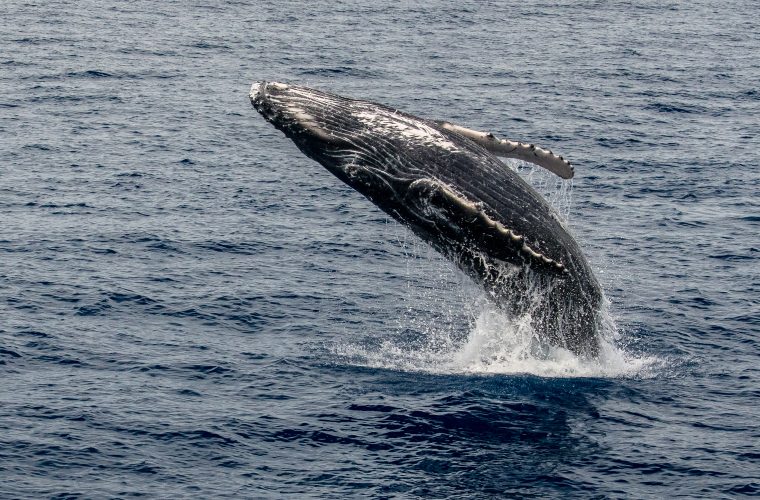
Whale season on Maui is a fantastic time of year. Normally, we start to see whales migrate to the Hawaiian waters around late November – early December.
Approximately 12,000 humpback whales make their way towards Hawaii every year, and possibly even more! The trip from Alaska to Hawaii is approximately 3,000 miles each way. Humpback whales usually swim at a pace of 3-5 mph and it can take the whales approximately 6-8 weeks to reach their destination. The whales travel from Alaska where they feed and then arrive to Hawaii to mate, rear their young, and to give birth. At birth, they weigh an average of 1.5 tons and are usually 10-16 ft. in length. They grow very fast and nearly double their length during their first year. Baby humpbacks nurse for nearly 6 months on their mother’s milk (consisting of about 50% fat), drinking as much as 600 liters of milk per day to help prepare them for the trip towards colder waters. The lifespan of a whale is said to average around 50 years. The number of humpbacks in Hawaiian waters is increasing significantly every year. Up until 1986, they were hunted into near extinction, with the count thought to be less than 1,500. In 1986, the International Whaling Commission introduced a ban on commercial humpback whaling.
One of the reasons Maui is so popular is due to its radiant beauty. You can choose to snorkel, surf, stand up paddle board, watch sunrise and/or sunset on top of a 10,000 foot volcano, whale watching, drive the Road to Hana, snorkel Molokini crater, or just relax on the beach. Maui has a ton to offer! Some of the best whale watching in the world is located on our beautiful island of Maui. The waters surrounding Maui become a whales playground every winter. Maui has a front seat in witnessing these magnificent creatures, due to the shallow waters within the Auau Channel (located between Maui, Molokai and Lanai).
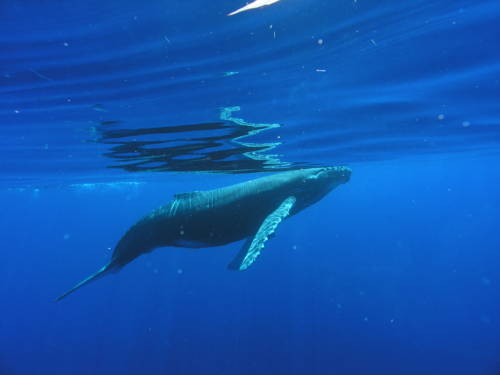 One of the great things about taking a Molokini snorkeling tour on the Four Winds II or the Maui Magic during whale season, is you will be able to check more than one item off your list, or what we like to call, a “twofer”. Enjoy the best snorkeling in Maui and snorkel Molokini and experience the Four Winds II glass bottom. You will get the chance to see some of the best whale watching on the way to your snorkel destination.
One of the great things about taking a Molokini snorkeling tour on the Four Winds II or the Maui Magic during whale season, is you will be able to check more than one item off your list, or what we like to call, a “twofer”. Enjoy the best snorkeling in Maui and snorkel Molokini and experience the Four Winds II glass bottom. You will get the chance to see some of the best whale watching on the way to your snorkel destination.
History on Whaling and Hawaii
Not only was Lahaina the capital of the Kingdom of Hawaii from 1820 to 1845, but it was also the center of whaling in Hawaii. In 1845, the capital moved to Honolulu. During 1820 to 1845, Lahaina was known as the the Pacific’s top whaling port. Whaling ships (responsible for hunting the sperm whales for whalebone, but mainly for the oil from the whale blubber) anchored in Honolulu and Lahaina. The impact of whaling vessels within Hawaii shaped the Hawaiian economy and was the primary source of income for the islands until about 1854. Whalers were hunting thousands of whales each year and was headed towards extinction. Luckily today we have laws that protect the whales, which has helped increase the population in Hawaii.
When Do We Normally See the Humpback Whales in Maui?
From December through March, you can join us on our daily Maui snorkeling tours to see the spectacular Humpback Whales. Experience the Humpback Whales in their natural habitat during their annual migration to Maui’s coastal waters as they come here to calve & mate. Whale watching is a part of both our Morning Molokini Snorkel Tours and the Afternoon Snorkel to Coral Gardens tour.
The island of Maui is the second largest island in the Hawaiian Island chain and is approximately 727 square miles. Maui is the 17th largest island in the United States. Technically, the County of Maui also includes Kahoʻolawe, Molokaʻi, and Lānaʻi.
Did you know that the Humpback Whales don’t eat while they are in Maui ? They live off their body fat while they are here. The whales hunt and feed during the summer months in the cold Alaskan waters before migrating toward Hawaii to give birth and mate. We just don’t have the food supply they need here!
Humpback Whales often travel alone or in a small groups. In most cases, a pod may consist of a mother whale, her baby, and an escort whale. The escort is male whale, not necessarily the father of the calf, that joins the mother to help protect the young calf while migrating.
A female whale can bear offspring once every 2-3 years and average duration of gestations for the calf is 12 months. Even if not carrying a calf , some females will still make the annual trip from Alaska to Maui.
Whale Behavior
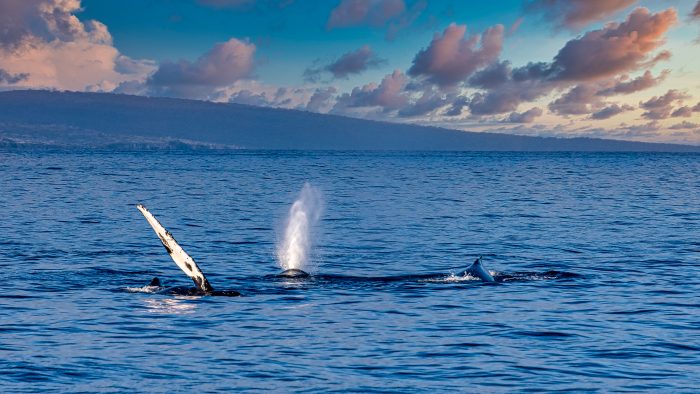 For a humpbacks, the purpose for this exciting display of power is not completely understood, but there are some interesting suggestions. Young whales likely breach as a form of play or to develop their muscles. The whales actions are a learned behavior, which would make sense when you see the mother breach with the calf following many times over.
For a humpbacks, the purpose for this exciting display of power is not completely understood, but there are some interesting suggestions. Young whales likely breach as a form of play or to develop their muscles. The whales actions are a learned behavior, which would make sense when you see the mother breach with the calf following many times over.
Adults likely breach in certain circumstances to transmit a message to members of their group. In fact, as breaching requires a significant amount of energy. A whale may breach to demonstrate its physical abilities; a very convincing signal. Less often, it seems that there are other explanations for breaching. It could be a technique to help cetaceans feed by stunning or scaring prey, and/or could be a good way of getting rid of external parasites. Another possibility is it could also be a method for inhaling water-free air in rough weather. What is certain, is that this behavior is spectacular for those observing it from the surface.
Since mating and birthing of calves occur in Hawaii, your whale watching experience is especially enhanced for a number of reasons. Some of the most visible action comes from competition between males vying for attention of females; kind of like a singles club for Humpbacks! Males navigating for a closer position to a female can create a lot of commotion, including exposed fins and tails!
While you are out whale watching, you’ll see many different behaviors performed by the humpbacks, a lot of them involving the tail. The flukes (tail), which can be 18 feet wide, is serrated and pointed at the tips. The shape and color, mostly black and white, on the humpback whale’s flukes are as individual in each animal as fingerprints in humans. The fluke up dive will be the most witnessed behavior. Unfortunately, that also usually means goodbye because the he/she is diving deep. The tail of the whale will appear from out of the water in an upward arch and slowly roll underwater in conjunction with a dive. This is also called sounding.
Another common whale behavior is a tail slap. This is when the whale lifts it’s fluke out of the water and slaps it down forcefully, sometimes over and over. This could be a form of communication with the other whales. The 3rd tail behavior is called a tail slash. This energetic display is when the whale throws it’s entire back end out of the water and slaps it on the surface. It’s almost looks like it’s doing a cartwheel in the water! This action is mostly an act of aggression or defense.
Resource Protection of the Humpback Whales
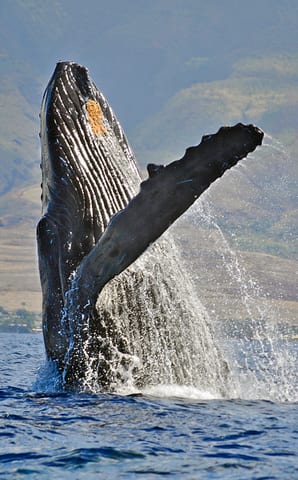 Federal regulations prohibit approaching humpback whales (by any means) within 100 yards (90 m) when on or in the water, and 1,000 feet (300 m) when operating an aircraft. These regulations apply to all ocean users, year-round throughout the Hawaiian Islands. Regulations are in place to protect humpback whales in the sanctuary and also apply anywhere within Hawaiian waters per the Endangered Species Act. Enforcement of these regulations are coordinated by the NOAA Office of Law Enforcement (OLE) with the U.S. Coast Guard (USCG), State of Hawaiʻi Department of Land and Natural Resources Division of Conservation and Resource Enforcement (DOCARE) and the NOAA Office of General Counsel.
Federal regulations prohibit approaching humpback whales (by any means) within 100 yards (90 m) when on or in the water, and 1,000 feet (300 m) when operating an aircraft. These regulations apply to all ocean users, year-round throughout the Hawaiian Islands. Regulations are in place to protect humpback whales in the sanctuary and also apply anywhere within Hawaiian waters per the Endangered Species Act. Enforcement of these regulations are coordinated by the NOAA Office of Law Enforcement (OLE) with the U.S. Coast Guard (USCG), State of Hawaiʻi Department of Land and Natural Resources Division of Conservation and Resource Enforcement (DOCARE) and the NOAA Office of General Counsel.
The following activities are prohibited within the sanctuary:
(a) The following activities are prohibited and thus unlawful for any person to conduct or cause to be conducted.
(1) Approaching, or causing a vessel or other object to approach, within the Sanctuary, by any means, within 100 yards of any humpback whale except as authorized under the Marine Mammal Protection Act, as amended (MMPA), 16 U.S.C. 1361 et seq., and the Endangered Species Act, as amended (ESA), 16 U.S.C. 1531 et seq.;
(2) Operating any aircraft above the Sanctuary within 1,000 feet of any humpback whale except as necessary for takeoff or landing from an airport or runway, or as authorized under the MMPA and the ESA;
(3) Taking any humpback whale in the Sanctuary except as authorized under the MMPA and the ESA;
(4) Possessing within the Sanctuary (regardless of where taken) any living or dead humpback whale or part thereof taken in violation of the MMPA or the ESA;
(5) Discharging or depositing any material or other matter in the Sanctuary; altering the seabed of the Sanctuary; or discharging or depositing any material or other matter outside the Sanctuary if the discharge or deposit subsequently enters and injures a humpback whale or humpback whale habitat, provided that such activity:
(i) Requires a Federal or State permit, license, lease, or other authorization; and
(ii) Is conducted:
(A) Without such permit, license, lease, or other authorization, or
(B) not in compliance with the terms or conditions of such permit, license, lease, or other authorization.
(6) Interfering with, obstructing, delaying or preventing an investigation, search, seizure or disposition of seized property in connection with enforcement of either of the Acts or any regulations issued under either of the Acts.
(b) The prohibitions in paragraphs (a)(1) through (a)(5) of this §922.184 do not apply to activities necessary to respond to emergencies threatening life, property or the environment; or to activities necessary for valid law enforcement purposes. However, while such activities are not subject to paragraphs (a)(1) through (a)(5) of this §922.184, this paragraph (b) does not exempt the activity from the underlying prohibition or restriction under other applicable laws and regulations (e.g., MMPA, ESA, and CWA).
(c) Any Sanctuary fishery regulations shall not take effect in Hawaii State waters until established by the State Board of Land and Natural Resources.
Molokini Snorkeling and Whale Watching
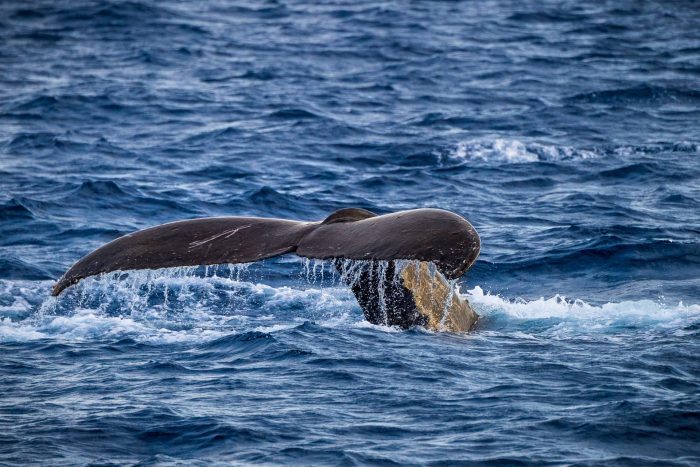 Snorkeling Molokini is an exciting and rewarding experience. Even if you are not an experienced swimmer, you can join in on the #1 Maui snorkel boat trip to Molokini! The Four Winds II is great for all ages and levels of swimmers. Guests can enjoy the glass-bottom viewing room and our super-fun water slide!
Snorkeling Molokini is an exciting and rewarding experience. Even if you are not an experienced swimmer, you can join in on the #1 Maui snorkel boat trip to Molokini! The Four Winds II is great for all ages and levels of swimmers. Guests can enjoy the glass-bottom viewing room and our super-fun water slide!
Molokini Crater is a popular destination for whale watching, snorkelers, scuba divers, and SNUBA diving. The crescent shape of Molokini crater protects swimmers and divers from waves and powerful currents. The winds are calmer in the morning and the trade winds tend to pick-up around the afternoon time. Molokini crater contains beautiful coral reefs and about 250 different species of fish. The visibility at the crater is excellent and can be up to 150 ft.
Molokini Crater is a protected Marine Life Conservation District and the island has been declared a Hawaii State Seabird Sanctuary. The crater is home to two species of nesting birds: Wedge-tailed Shearwaters and Bulwers Petrels. Shearwaters have a thin beak and feed on fish crustaceans. Bulwer’s Petrels spend most of their time at sea and are quite small yet have a long wingspan and are known for breeding on the north Pacific Islands (Hawaii and China).
Whale Watching is Dependent on Nature
It is impossible to guarantee the spotting of marine life in the wild, due to weather conditions and nature. Just like any wild animal, they have a mind of their own. Our captains try their best to search for whales during your Maui snorkel excursion. Some of our captains that have been working on our boats for over 30 years, and still, every whale season is like Christmas day.
Whale Songs
The humpbacks majestic whale songs are often heard while snorkeling in Maui. Both male and female humpback whales can produce sounds, however only the males produce the long, loud, complex “songs” for which the species is famous. These complex songs can be heard for miles and can last anywhere from 20 minutes to 24 hours!
What exactly is a whale song? A whale song is a pattern of predictable sounds that are created by whales. These predictable sound patterns actually resemble notes of a song. Music composers are in awe of the melodies that are created by these amazing animals.
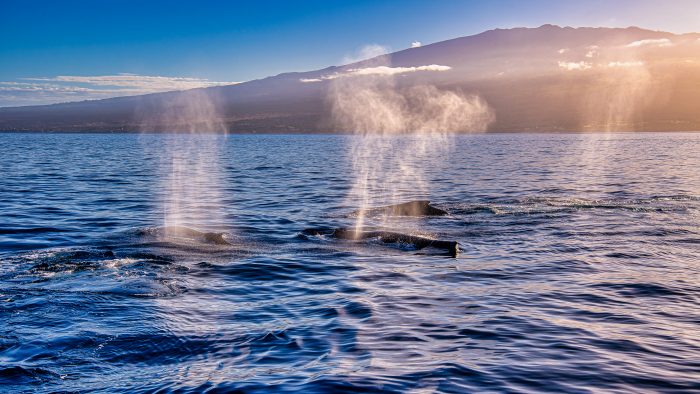
Of course, the actions the whales do above the water are exciting to see, but what does it sound like under the water? The Four Winds and the Maui Magic both have hydrophones, which are basically water proof microphones that we drop down in the water to about 10 feet. Each song consists of several sounds in a low register that vary in amplitude and frequency, and typically lasts from 10 to 20 minutes. Songs may be repeated continuously for several hours; humpback whales have been observed singing continuously for more than 24 hours at a time. These whales actually have no vocal cords, but generate their song by forcing air through their massive nasal cavities. Whales within a region sing the same song, for example, all of the humpback whales of the North Atlantic sing the same song, and those of the North Pacific sing a different song. Each population’s song changes slowly over a period of years, never returning to the same sequence of notes!
A Review From Our Guest Steve S. from January 2016
“Very well run tour. I was really impressed with the staff, they called me by name from the time I checked in until we got off the boat – – I wish I was that good at remembering names! Due to sea conditions beyond their control, we only got to snorkel at one location but it was beautiful! We also got to see awesome whale activity. In fact the tour would have been worth the money even without the snorkeling based on the whale watching. They dropped an underwater microphone into the water and let us listen to the whales for a few minutes, very cool! By the way, as an added bonus we had one of the best burgers i had all week, grilled on the boat for us at lunchtime. We found this tour to be an excellent value – – snorkeling, whale watching, and 2 meals (breakfast and lunch) all rolled into the cost.”
***The Four Winds II and the Maui Magic are proud to assist in conservation and protection of the coral reefs surrounding Maui, Hawaii. We strive to help educate everyone we take snorkeling. We encourage guests to use Reef Safe Sunscreen (also offered onboard all our vessels) and ask you to not touch marine life as it can be damaging to the fragile coral and ecosystem.